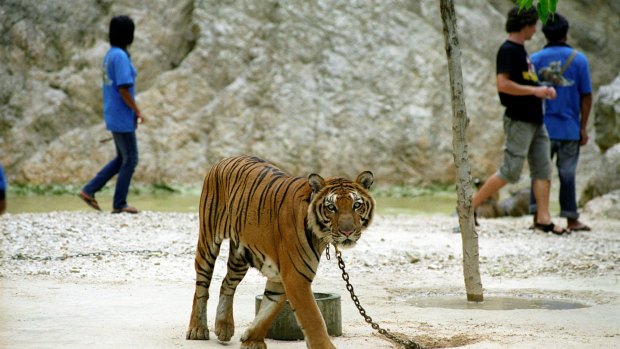This was published 9 years ago
Tinder guys with tigers are aiding animal abuse

Main offender: Thailand is home to places like the "Tiger Temple" in Kanchanaburi, a so-called sanctuary for tigers that tourists can visit and pose with one of the huge cats for a quick Tinder photo. Credit: Alamy
It's a "thing" on Tinder, apparently. The online dating app is filled with pictures of men with their shirts off, men sitting on or standing near motorbikes, and men posing next to tigers. Proper, live, full-grown tigers.
It's the tiger photos that are the strangest, and surprisingly most common. I don't know what the guys are trying to achieve here, whether it's a Bear Grylls-style "check out how daring I am" type thing or more of a cuddly "look at my way with animals" scenario, but Australian men seem to love posting photos of themselves in the proximity of huge stripey cats (for evidence, check out the website tinderguyswithtigers.tumblr.com).
This would not ordinarily be a topic for the travel pages – more something to cover in the relationships section, or in an article on the bizarreness of the male psyche. But it's the way guys get these tiger photos that's the issue.
It's usually overseas. And it's often in dodgy circumstances.
Thailand seems to be the main offender. The country is home to places like the "Tiger Temple" in Kanchanaburi, a so-called sanctuary for tigers that tourists can visit and pose with one of the huge cats for a quick Tinder photo. Or just a standard selfie.
There's anywhere up to 70 tigers kept at the temple at any one time, ranging in age from cubs to full-grown beasts. Tourists just have to cough up a few baht for the privilege of posing next to one, or, for a few more baht, cuddling a small one.
While accusations that the sluggish felines have been drugged remain unproven, there are still plenty of issues with keeping all these wild animals in captivity and parading them around each day for singlet-clad Romeos to prove their worth to potential Tinder dates.
For starters, breeding and keeping a wild animal in captivity doesn't make it a wild animal. It makes it a very unhappy pet. The tigers aren't exercised, and the cute, cuddly ones are overfed by gawping tourists who, once again, pay for the privilege. The non-cute ones just lie around and get fat.
The huge problem with all of this, of course, is that it's an industry that actively encourages the mistreatment of animals, and it's propped up purely by us: tourists. And it's not the only one. Across the world this is happening, from the small-time keeper of a few "dancing bears" in India to the enormity of the United States version of SeaWorld, with its captive orcas (keeping a large marine mammal in a small tank is inhumane – who knew?).
And we become part of these industries without even blinking.
When you travel, it's so easy to ignore your normal morals and values in favour of doing something that seems really cool. (For evidence of this, check out any nightclub on a Greek island.)
I went to the San Fermin festival, or the Running of the Bulls, in Pamplona, Spain, and had a ball, despite the fact the bulls doing the running are clearly being treated in a way I'd normally be uncomfortable with.
I went to a bullfight in the name of experiencing culture. And it is cultural – but it's also pretty disturbing.
I've ridden an elephant before. Actually, a few times. First was in Zimbabwe, where you could pay a crazy amount of money to sit on the back of an elephant while it goes for a swim in a lake. The upside is feeling a close connection to a huge animal. The downside is when it poops into the water and you have to try to avoid the floating chunks.
I rode an elephant in Laos, too, taking a little tour of a forested region near Luang Prabang from a little bamboo seat atop its big leathery back.
Those were fun experiences, but what you have to choose not to think about is that no wild animal like an elephant should be tame enough to be able to sit on. In order for that to happen, they have to be "broken". That's not right.
It's so not right, in fact, that earlier this year Intrepid Travel announced that none of its future tours would include rides on elephants. The company has become uncomfortable with the treatment of the animals, and no longer supports their captivity in the name of tourism. That's a great step. But individual travellers still have to take responsibility here.
Don't pay people to release birds from cages. It creates an industry. Don't pay to ride wild animals. Don't pay to watch bears or monkeys dance or play the guitar (as clearly hilarious as it is). Don't go along to things like bullfights or cockfights in the name of experiencing culture if it's a culture you wouldn't practice at home.
And don't pose with tigers for your Tinder profile.
Sign up for the Traveller newsletter
The latest travel news, tips and inspiration delivered to your inbox. Sign up now.